I’ve been longing to post this oven baked teriyaki salmon recipe. With many wanting to eat healthier at the start of the year, some still in party mode and lunar new year on the horizon – what more perfect time could there be?
If you love Japanese fare, you’re going to love this karaage chicken and these air fryer teriyaki chicken drumsticks as well.
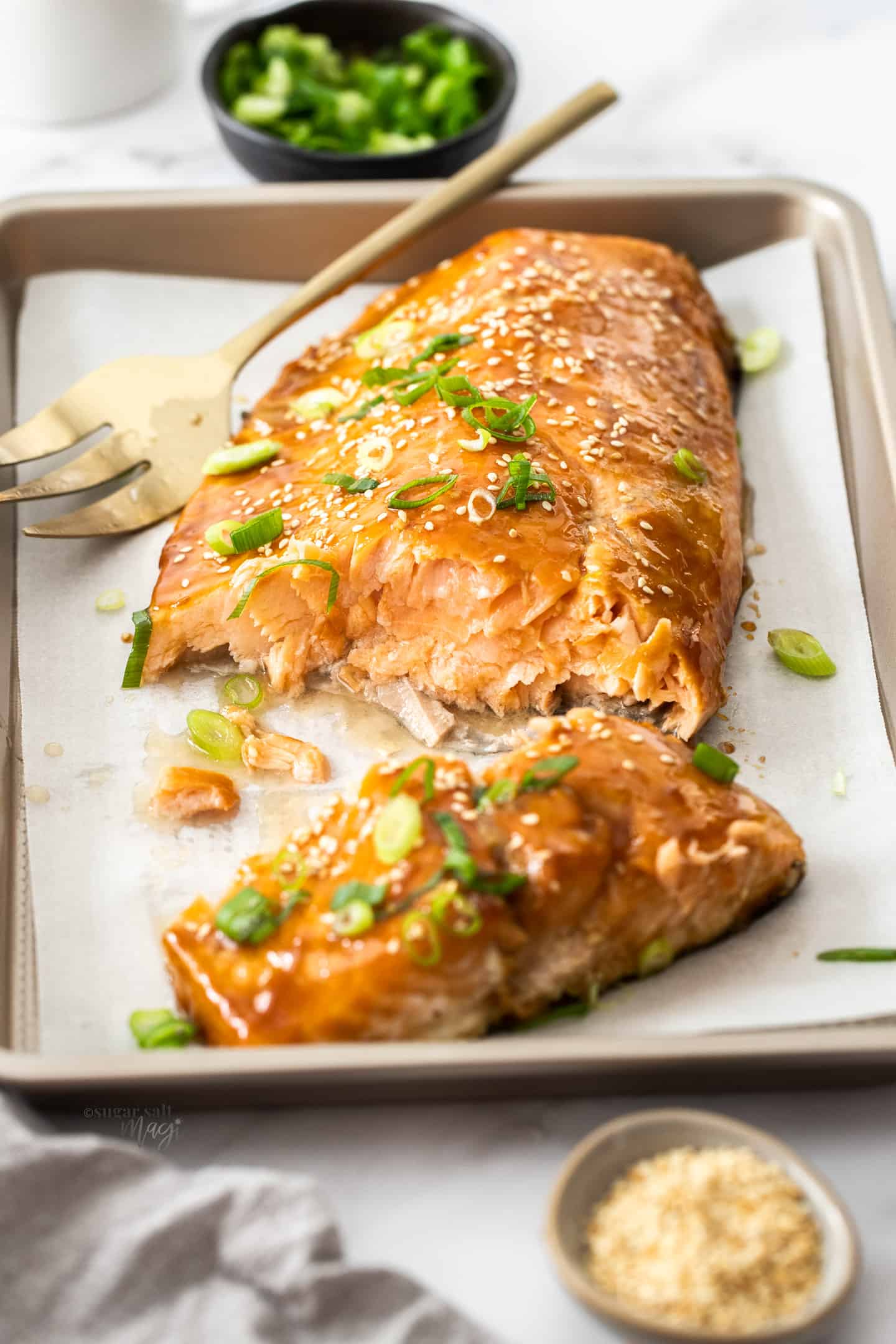
Table of contents
Why you’ll love it
Rich in flavour with a sweet, sticky teriyaki glaze, baked teriyaki salmon comes out of the oven moist, flaky and so delicious. Cooking a half side of salmon like this looks super special too so it’s great for a small dinner party or just spoiling your family.
It’s quick and easy too. You can make the sauce ahead of time but even if you don’t this will be done in under 45 minutes. The salmon bakes in the oven in around 15-20 minutes, depending on the thickness and the only other thing you need do is cook up the sauce.
Perfect for any night of the week or for when you want to impress guests, this sticky, sweet and savoury teriyaki salmon is an absolute winner. You don’t need any special tools or knowledge to make this incredibly special dish.
What is teriyaki
Teriyaki is a dish of Japanese origin, of meat or fish, marinated in a sweet and salty sauce then grilled. Most popular is teriyaki chicken but beef and salmon are close runners up.
Teriyaki literally translates to “shine grilled” in reference to it’s glossy look and the way it’s traditionally cooked.
Traditionally, teriyaki sauce does not use cornflour (aka cornstarch) like I have here. It’s added into this recipe to allow it to turn into a thick glaze that coats the salmon and doesn’t just run off.
Does teriyaki sauce have honey?
Authentic teriyaki does not have honey. Traditional teriyaki sauce has a sweet Japanese wine called “mirin” and a little sugar so some recipes over the years have been adapted to use honey in place of those two ingredients.
For me though, teriyaki should not have a honey flavour which anything you add honey to, will.
Tools you’ll need
- A baking tray, half sheet pan or baking dish just larger than the salmon.
- Saucepan
Ingredients you’ll need
You have to love a dinner with 8 ingredients. Just add some rice and steamed veg and you have a wonderful, easy meal that everyone will love.
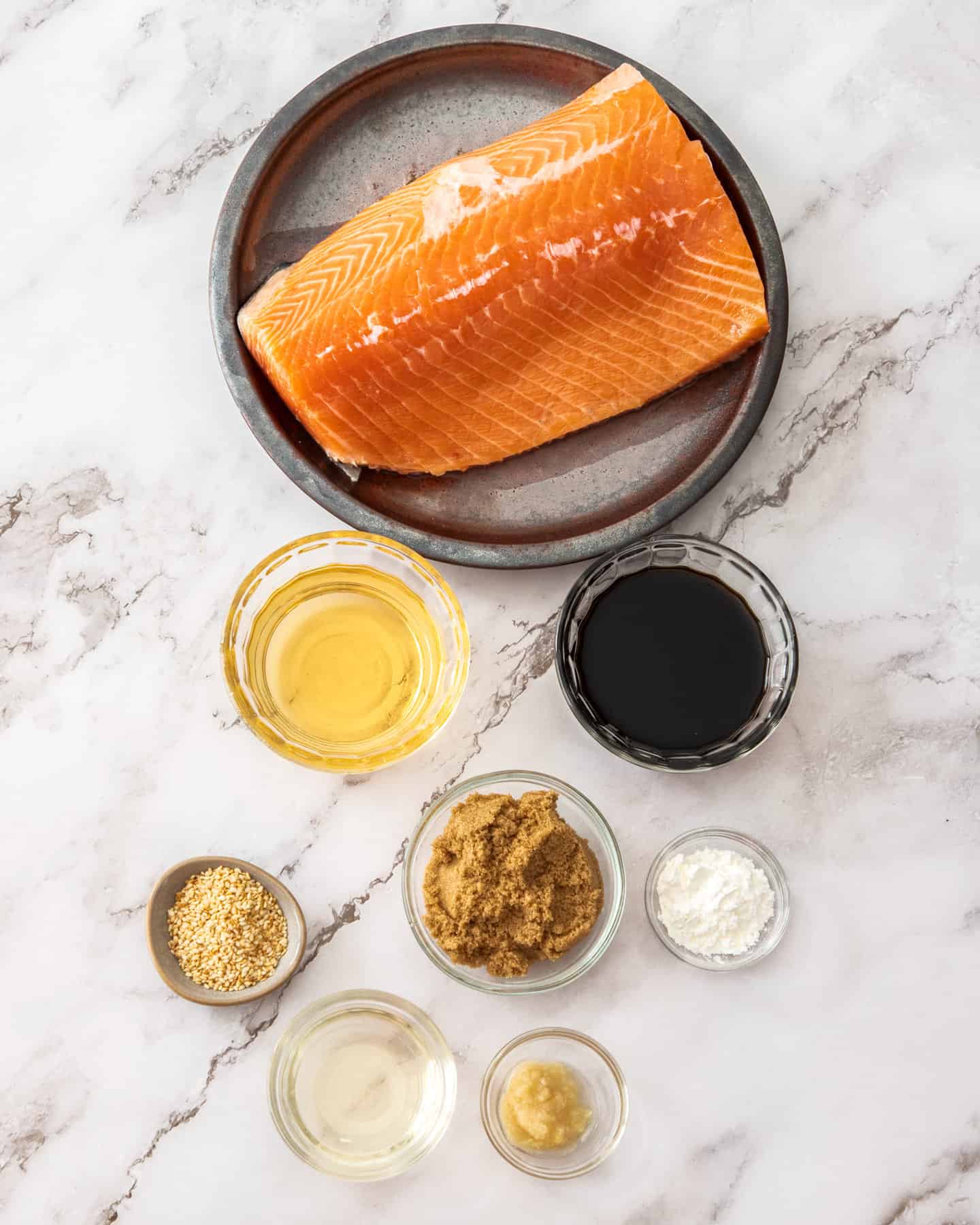
Detailed quantities and instructions in the recipe card below.
- Salmon: I use roughly half a side of salmon (around 675g / 1 ½ pounds). You can use salmon steaks, though you’ll need to alter the cooking time to suit.
- Soy sauce: Soy sauce is your seasoning, your salt, in this recipe. I find a light soy sauce to give the best flavour in this sauce.
- Mirin: Mirin is a Japanese sweet wine used in cooking. It has a bit of a syrupy texture and is just a light sweetness. I recommend going out of your way to get this for a truly authentic teriyaki flavour. It’s readily available these days in grocery stores.
- Brown sugar: This rounds out the typical sweetness you need in teriyaki sauce. While white sugar will work, I find the flavour of brown works best.
- Ginger: Ginger and salmon, ginger and teriyaki – such great flavour combos. Make sure to use fresh or, at a minimum, jarred. Don’t use powdered ginger in this.
- Rice wine vinegar: Made from fermenting rice, rice wine vinegar is used in many Asian cuisines. You can substitute apple cider vinegar if you need to. Rice vinegar is readily available in most large grocery stores.
- Cornflour: Cornflour (aka cornstarch), while not typically used in teriyaki, is used in this sauce to give it the thickness of a glaze. This is so it doesn’t just run straight off the salmon and sticks to it when you baste.
- Sesame seeds: The perfect finish to some Japanese salmon has to be sesame seeds.
I finish this off with some finely chopped spring onions (scallions / green onions) too.
How to make teriyaki salmon
For such a simple meal this oven baked teriyaki pays big rewards on flavour and texture.
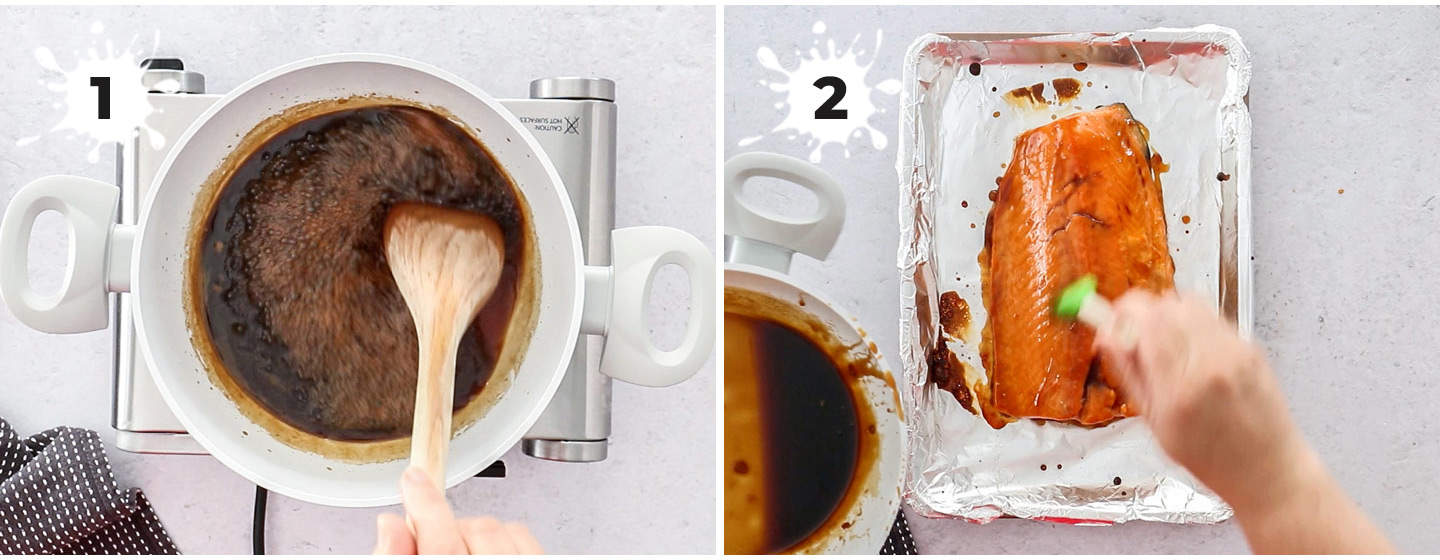
Detailed instructions in the recipe card below.
- Toast the sesame seeds: Start by toasting the sesame seeds in a saucepan over medium heat, shaking often, until they’re turning golden. Tip into a dish and set aside.
- Make the teriyaki salmon glaze: Use the same saucepan, add soy sauce, mirin, brown sugar and ginger and bring it to a boil (photo 1). Let it boil for a few minutes, then add the combined rice wine vinegar and cornflour (cornstarch) to thicken it up. Let it cool to around room temp.
- Bake the salmon: Place the salmon on a baking tray or baking sheet lined with foil or baking paper. Dry it off using paper towel. After setting aside some of the sauce for serving, brush half of the remaining sauce over the salmon (photo 2). Now bake it in a preheated oven for 15-20 minutes.
This really is an incredibly simple meal. The sauce can be made ahead of time and stored for 2-3 days in a preserving jar or airtight container until you need it.
This glaze doesn’t just work on salmon either. Use other types of fish, steak or chicken too.
Important notes
- Check your salmon for bones before cooking: Before you start cooking, run your fingers over the salmon. If you feel spiky bits, they are bones that need to be remove. Luckily, it’s very easy. Grab some clean tweezers (I keep a pair in the kitchen for this specific reason) and gently pull at the end of the bone – it will slip straight out. I deboned the piece you see in these pictures in about 5 minutes.
- The teriyaki salmon glaze does need to cool slightly before using it on the salmon or it may just slide right off. Make it then let it come to room temp or make it ahead of time (even the day before), so it’s ready to go when you are.
- Make sure to keep the serving glaze separate to the basting glaze. Set aside 2/3 cup of sauce for pouring over when you serve, then rest will be brushed onto the salmon before and during the cooking time, so it’s important they are kept separate for food safety.
- When is salmon done? According to the USDA, the internal temperature of salmon making it safe to eat should reach 63c / 145F. Food safety Australia say fish fillets should “be cooked to around 69°C or when flesh flakes easily”. Most people would find salmon dry and overdone at these stated temperatures though and I find the flesh flakes long before. Personally, I like it around 55C / 130F which is about medium doneness. The fish will still flake but be very moist. Many like it medium rare. Keep in mind, once you remove the salmon from the oven, it will continue to cook in the centre for a few minutes. I’m not a nutrition expert, so please decide what works for you.
Variations
If you love garlic, add a clove or two to the teriyaki glaze while cooking. You can also add dried chilli flakes or a bit of pepper for a kick of spice.
Sources
I was first inspired to bake a big slab or side of salmon like this by my friend, Ari, over at Well Seasoned Studio. She cooks her baked salmon a little different to how I do this one but without trying hers first, this one might never have happened.
For many years now, I’ve used a teriyaki sauce that I adapted from this version. The one on this salmon has been adapted much further to allow it to really stick to the salmon and leave you with a nice thick glaze whilst still tasting of a classic teriyaki.
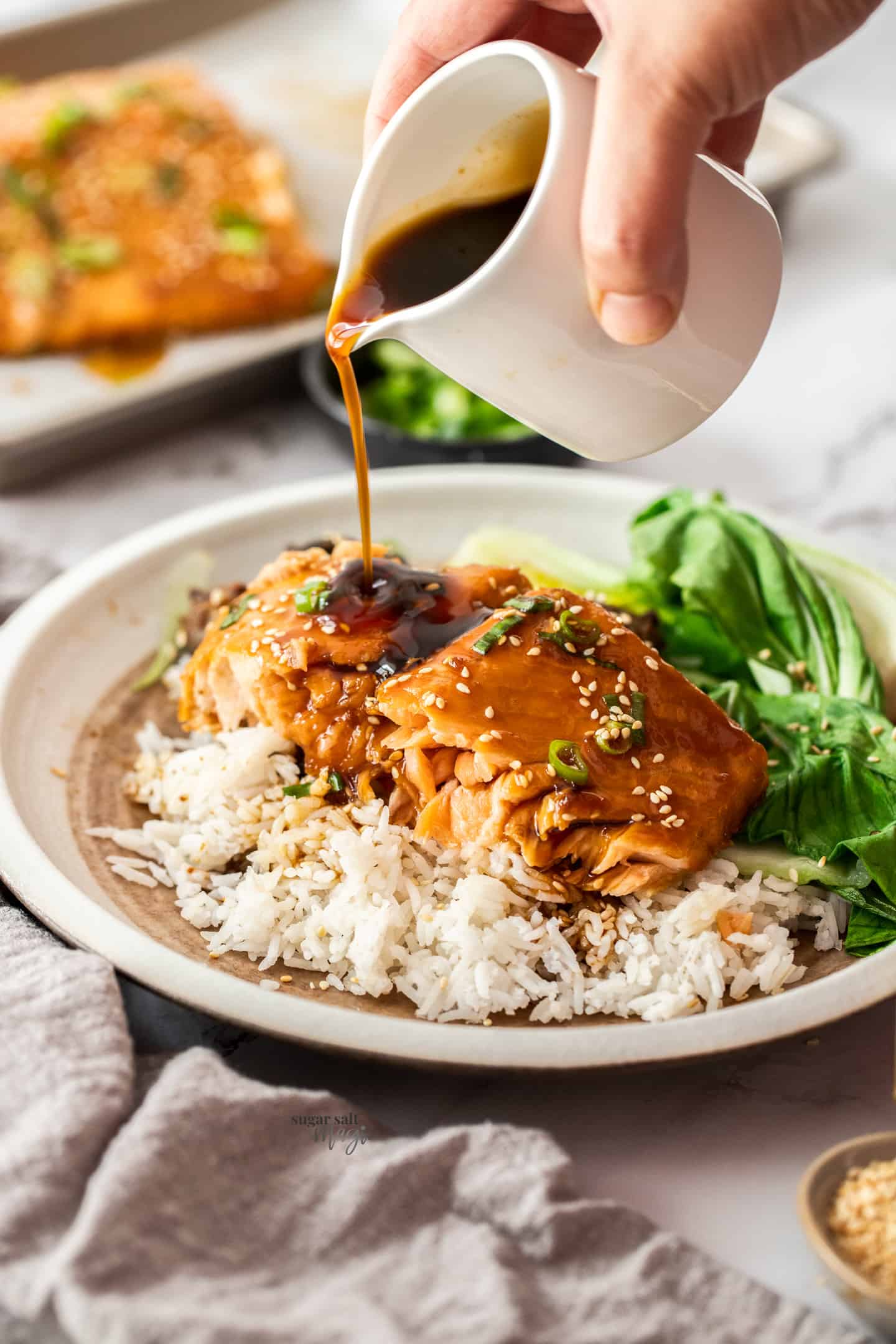
What to serve with teriyaki salmon
For more traditional sides, you could serve this oven baked teriyaki salmon with;
- Steamed rice – perfect for making it a complete meal and it’s subtle flavour allows the salmon to shine. It’s also perfect for mopping up the teriyaki sauce. You could also use cauliflower rice or quinoa.
- Sliced fresh cucumber – cool and refreshing, it’s a lovely contrast in texture but a light flavour that doesn’t mess bold teriyaki.
- Pink pickled onions – I make my own but Japanese pickled vegetables or even just some pickled ginger on the side are also lovely.
- Steamed vegetables – steamed broccoli, asparagus or snow peas are a lovely fresh side.
- Miso mushrooms – they’re hiding behind the salmon in the photo above but I love these and this recipe will be coming soon.
For some less traditional but still very satisfying sides, you could try this rainbow vegetable tray bake or this creamy cucumber salad.
Storing leftovers
This baked salmon is best eaten fresh, though you can certainly store leftovers in an airtight container for 2-3 days. Reheat it in the oven or microwave until hot through before eating.
Teriyaki salmon FAQ’s
Soy sauce contains gluten, so swap to tamari if you want to make this gluten-free. Some rice wine vinegars are also not gluten free, so swap to apple cider vinegar instead. For the mirin, check the packaging.
You can use salmon fillets for this recipe. The cooking time will change depending on their thickness but will be around 12-15 minutes.
While I prefer the tenderness of the fish when done in the oven, this recipe can be cooked on the stovetop and is best done using salmon steaks / fillets for ease of moving them around.
Cook the salmon until almost done, then pour in all of the sauce (that has been made ahead). Let it bubble and thicken, while turning the salmon steaks for another 2-3 minutes.
Bottled teriyaki sauce is not thick enough to coat this salmon and to properly glaze it. You could technically thicken some up with cornflour first but this homemade teriyaki sauce is so simple, there’s no need.
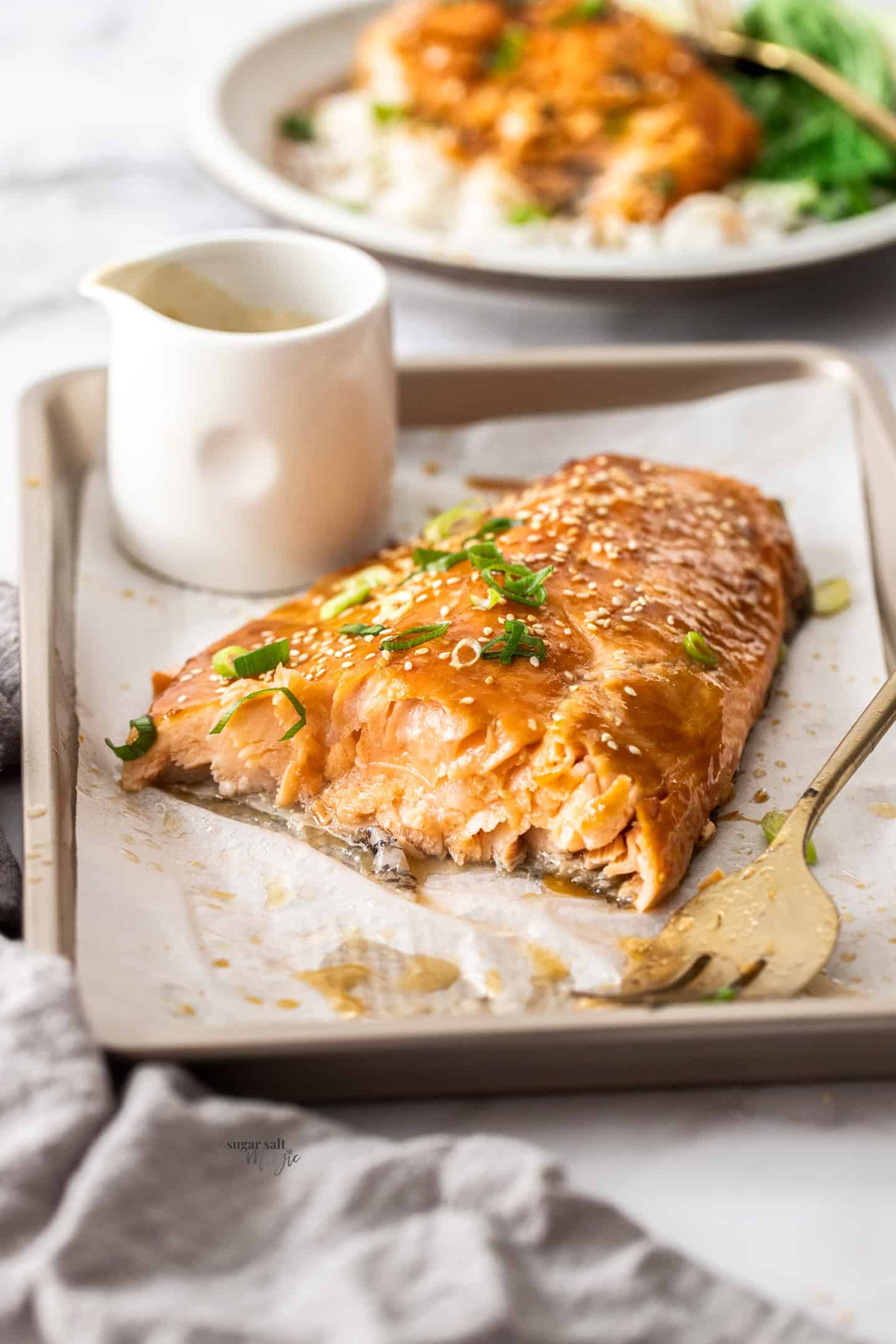
If you try this oven baked teriyaki salmon recipe, please take a moment to leave a rating and comment below. I love hearing from you and it helps other readers too! You can also take a photo and tag @sugarsaltmagic on Instagram.
More recipes you’ll love
- Beef teriyaki bowls
- Honey mustard salmon
- Furikake Salmon
- Pork Gyoza (Japanese Pork Dumplings)
- Air Fryer Teriyaki Chicken Drumsticks
- Sesame Prawn Toast
Never Miss a Recipe!
Get the latest recipes straight to your inbox!
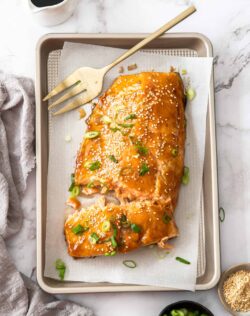
Ingredients
- 1 tablespoon sesame seeds (notes 1)
- ½ cup light soy sauce (125ml)
- ½ cup mirin (125ml)
- ⅓ cup brown sugar (70g / 2.5oz)
- 1 teaspoon ginger
- 2 tablespoons rice wine vinegar (notes 1)
- 3 teaspoons cornflour (cornstarch)
- 675 g slab of salmon (1 ½ lb)
- 2 spring onions (green onions / scallions)
For best results, always weigh ingredients where a weight is provided
Equipment
- A baking tray, half sheet pan or baking dish just larger than the salmon
- Saucepan
Instructions
- Place the sesame seeds in a medium saucepan and toast over medium heat, shaking up fairly often, until they start turning golden. Set them aside until the end.
- Make the teriyaki sauce at least ½ an hour ahead so it has time to cool a bit.
- In the same saucepan, combine the soy sauce, brown sugar, mirin and ginger. Bring to a simmer, stirring often, until sugar has dissolved. Let it simmer for 5 minutes to reduce slightly.
- Combine the vinegar and cornflour and mix to a slurry. Add to the sauce as you stir, then cook for 1 minute until thickened.
- Take salmon out of the fridge 15-30 minutes before you begin to get it close to room temperature – this helps with even cooking.
- Preheat oven to 200C / 395F / 180C fan forced. Line a rimmed baking tray, just larger than the salmon, with baking paper or foil, then rub a little vegetable oil over the tray so the salmon doesn't stick.
- Pat the salmon dry with a paper towel, then place on the baking tray, skin side down.
- Reserve ⅔ cup of the teriyaki sauce for serving time. Brush half of the remaining sauce over the salmon. Bake for 15-20 minutes (depending on thickness), basting with the remaining sauce another 2 times. Cook to your preferred doneness (notes).
- Let it rest for 5 minutes before serving.
- Garnish with the toasted sesame seeds and finely chopped spring onions. Serve over rice with the reserved sauce, steamed veggies.
Notes
- I use a standard Australian 20ml tablespoon (equal to 4 teaspoons).
- Check your salmon for bones before cooking: Before you start cooking, run your fingers over the salmon. If you feel spiky bits, they are bones that need to be remove. Luckily, it’s very easy. Grab some clean tweezers (I keep a pair in the kitchen for this specific reason) and gently pull at the end of the bone – it will slip straight out. I deboned the piece you see in these pictures in about 5 minutes.
- The teriyaki salmon glaze does need to cool slightly before using it on the salmon or it may just slide right off. Make it then let it come to room temp or make it ahead of time (even the day before), so it’s ready to go when you are.
- Make sure to keep the serving glaze separate to the basting glaze. Set aside ⅔ cup of sauce for pouring over when you serve, then rest will be brushed onto the salmon before and during the cooking time, so it’s important they are kept separate for food safety.
- According to the USDA, the internal temperature of salmon making it safe to eat should reach 63c / 145F. Food safety Australia say fish fillets should “be cooked to around 69°C or when flesh flakes easily”. Most people would find salmon dry and overdone at these stated temperatures though and I find the flesh flakes long before. Personally, I like it around 55C / 130F which is about medium doneness. The fish will still flake but be very moist. Many like it medium rare. Keep in mind, once you remove the salmon from the oven, it will continue to cook in the centre for a few minutes. I’m not a nutrition expert, so please decide what works for you.
This post may contain affiliate links that earn me a small commission for my referral, at no extra cost to you. Thank you for supporting Sugar Salt Magic.

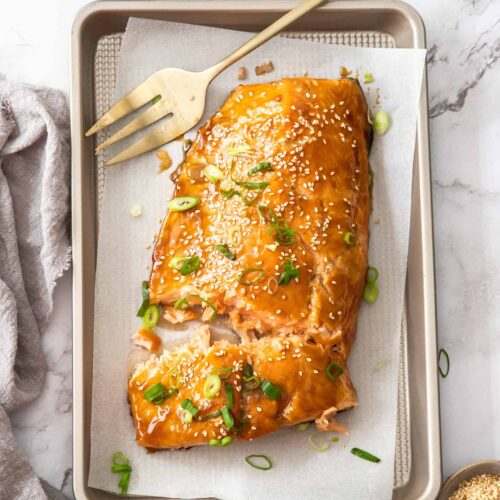
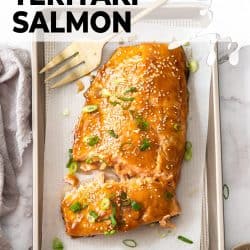

4 Comments on “Oven Baked Teriyaki Salmon”
The sauce is a bit strong what would you suggest I do
Bev
Hi Bev. It depends what you mean by “strong”? If you find it too salty, you can add some more sugar and maybe a little water. If it’s too tangy, you also might need a bit more sugar. If it’s too thick, just water it down a touch.
I used this recipe to make a salmon bowl with veggies and it came out perfectly! I’d highly recommend. The only change I made was I substituted mirin with a little more rice wine vinegar.
Thank you so much Krystal. So happy you love it 🙂